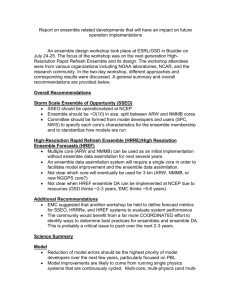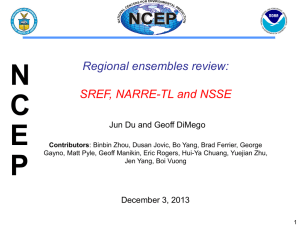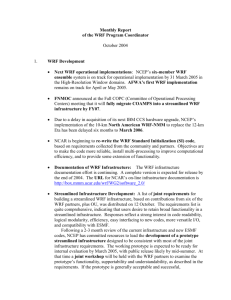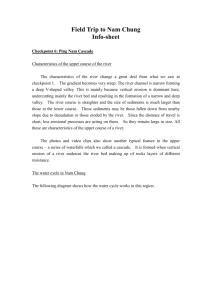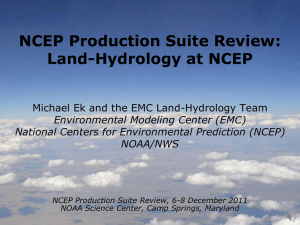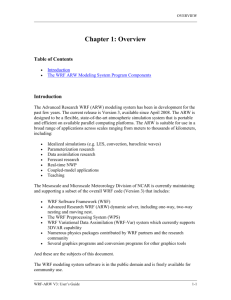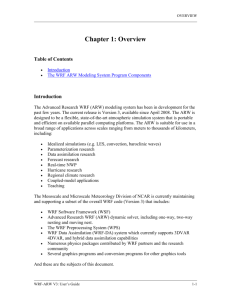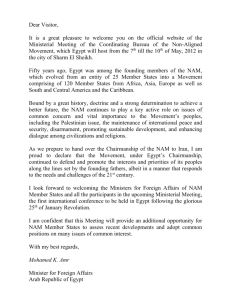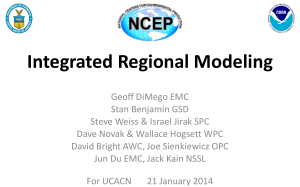ppt
advertisement
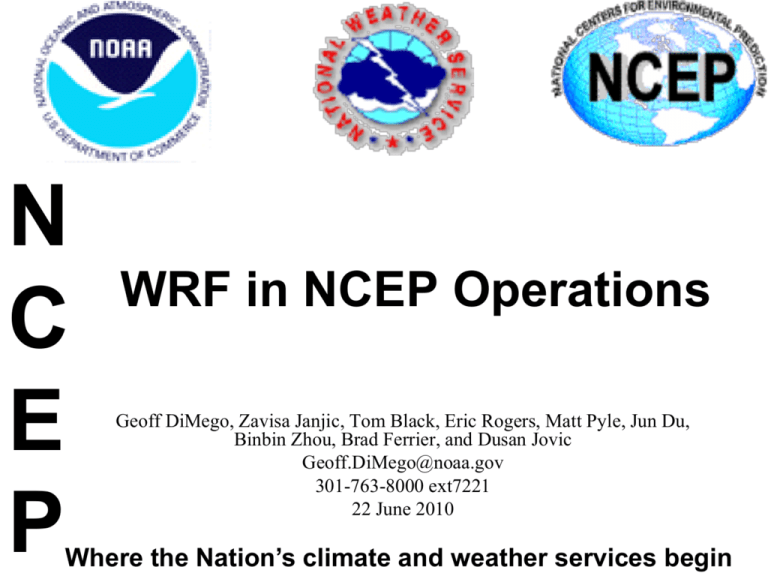
N C E P WRF in NCEP Operations Geoff DiMego, Zavisa Janjic, Tom Black, Eric Rogers, Matt Pyle, Jun Du, Binbin Zhou, Brad Ferrier, and Dusan Jovic Geoff.DiMego@noaa.gov 301-763-8000 ext7221 22 June 2010 Where the Nation’s climate and weather services begin TOPICS • • • • • • Condensed Chronologies Unsolicited Endorsements HiResWindow & Radar Use in GSI Short Range Ensemble Forecast (SREF) North American Mesoscale (NAM) Future Plans: NMMB & NEMS 2 NMM, ARW in NCEP Operations • Pre-WRF NMM at NCEP • WRF-ARW at NCEP • May 2000: nonhydrostatic option released in upgrade to NCEP‟s workstation Eta • May 2001: NMM model equations, solution techniques & test results published in Janjic, Gerrity, and Nickovic, 2001, Mon. Wea. Rev. also Janjic, 2003, Meteor. & Atmos. Phys. • February 2002: HiResWindow runs upgraded to use 8 km NMM replaces 10 km Eta (hydrostatic) • February 2002: On-Call Emergency Response (OCER) capability begins using 4 km NMM to support HYSPLIT • May 2003: Fire Weather / IMET Support runs implemented using 8 km NMM • September 2004: HiResWindow first WRF implementation of 10 km WRFARW v1.3 • June 2005: HiResWindow upgraded to use 5.8 km WRF-ARW with explicit convection • December 2005: Short Range Ensemble Forecasting system adds 3 members using 45 km WRF-ARW v2.0 • September 2007: HiResWindow expanded domain and upgraded to 5.1 km WRF-ARW v2.2.1 • October 2009: SREF WRF-ARW upgraded to v2.2.1, add 2 members and increase resolution to 35 km 3 WRF-NMM in NCEP Operations • April 2004 thru present: NSSL/SPC Spring Program, daily developmental run of 4.5 km WRF-NMM with explicit convection • September 2004: HiResWindow first WRF implementation of 8 km WRF-NMM v1.3 replaces pre-WRF NMM • June 2005: HiResWindow upgraded to use 5.1 km WRF-NMM with explicit convection • December 2005: Short Range Ensemble Forecasting system adds 3 members using 40 km WRF-NMM v2.0 • June 2006: NAM runs use 12 km WRF-NMM v2.1 & WRF-GSI replacing Eta & Eta-3DVar • September 2007: HiResWindow expanded domain and upgraded to 4 km WRF-NMM v2.2.1 • December 2008: final major NAM/NMM upgrade 4 Recommended Talks + Tutorial • Session 2: WRF Model Development and Operations – 2.2 NCEP Operational Hurricane WRF (HWRF) Modeling System. Vijay Tallapragada (NCEP/EMC), Qingfu Liu, Young Kwon, Zhan Zhang, Robert Tuleya, Janna O'Connor, Samuel Trahan, Naomi Surgi, Bill Lapenta, and Stephen J. Lord • Session 4: Physics Development and Testing – 4.8 Test Results of Hurricane Related Inland Streamflow Forecasts. Yihua Wu (NCEP), and Michael Ek GSI Community Tutorial June 28-30, 2010 5 Recommended POSTERS 2:30 P.M. – 5:30 P.M, Wednesday, June 23 • WRF Model Development – P.1 Development and application of the Unified Post Processor for WRF NMM, WRF ARW, and GFS. Hui-Ya Chuang (NCEP) • Future updates will include Ri-based PBL height (to be compatible with NCEP‟s verification & analysis projects which are based on diagnosing PBL height from radiosonde, aircraft & Profiler soundings using critical Ri (=0.25) [ see next slide ] • Physics Development and Testing – P.44 Some Cold Region Physics Issues in WRF. Yihua Wu (NOAA/NCEP/EMC), and Michael Ek – P.45 Impacts of the new Satellite Derived Land Products for WRF. Vince Wong (NCEP/EMC), and Michael Ek 6 NAM 12 hr Forecast Ri-Based PBL Height with Verifying RAOBs 7 HiResWindow Fixed-Domain Nested Runs Configuration/Schedule as of September 2007 • 4-5 km explicit runs of both NMM & ARW at same time every day - if & only if no hurricane runs are needed • 00Z : ECentral & Hawaii • 06Z : WCentral & Puerto Rico • 12Z : ECentral & Hawaii • 18Z : Alaska & Puerto Rico • Daily displays of both ARW + NMM are at: http://www.nco.ncep.noaa.gov/pmb/nwprod/analysis/ (see next slide for example) and http://www.emc.ncep.noaa.gov/mmb/mmbpll/nestpage/ • Promised to ‘appear’ on AWIPS-Satellite Broadcast Network and NOAAport 8 HiResWindow Western Nest T 250-200mb Verification Stats RMS vs ACARS Dec 2009-Mar 2010 wind 250-200mb T 700-550mb wind 700-550mb T 850-700mb wind 850-700mb 9 Frequency of HiResWindow Runs Typically, no runs at all 50% of time in July & August 1 0.8 0.7 ALL HIRESW runs NO large ARW NO large NMM/ARW NO HIRESW 0.6 0.5 0.4 0.3 0.2 0.1 N r ov em be r ob e O ct m be r t pt e gu s Se Au Ju ly Ju ne ay 0 M Ratio of total model cycles 0.9 10 Model Analyses & Forecast Page ARW Simulated Radar Reflectivity 11 Model Analyses & Forecast Page NMM Simulated Radar Reflectivity 12 Model Analyses & Forecast Page NMM Sim. Radar Reflectivity w/Zoom 13 Matt Pyle Webpage 14 HiResWindow 2010 Upgrade • • • • • • Upgrades WRF-NMM from v2.2 to v3.2 and switch to use new, more conservative Eulerian advection for passive quantities (moisture, cloud, condensate and TKE). Upgrades WRF-ARW from v2.2 to v3.2 and switch to use positive definite advection for passive quantities (moisture, cloud and hydrometeors). Adds hybrid ensemble (Du 2004) products generated by applying SREF „anomalies‟ to HiRes base fields to produce a 44 member ensemble from which probabilities can be computed (e.g. Prob. Of Exceedance for critical QPF amounts for Washington‟s Hanson Dam) Adds twice daily runs for Guam (these replace legacy RSM runs for Hawaii) Adds generation of BUFR output (hourly point forecasts) from both cores. 15 Implementation is currently delayed due into FY2011. HiResWindow WRF v3.2 Configurations (No Parameterized Convection) Dynamic Core WRF-NMM WRF-ARW Horizontal Spacing 4.0 km 5.1 km Vertical Domain 35 levels 50 mb top Sigma-Pressure 35 levels 50 mb top Sigma PBL/Turbulence MYJ YSU Microphysics Ferrier WSM3 Land-Surface NOAH NOAH Radiation (Shortwave/Longwave) GFDL/GFDL Lacis-Hansen/Fels-Schwartzkopf Advection of Passive Variables Conservative Positive Definite Dudhia/RRTM Monotonic Positive 16 Definite ARW p03 NMM p03 SREF Ensemble mean p03 Hybrid Ensemble mean p03 17 HiResWindow 2010 Upgrade Testing & QFP Test Results Summary • Upgraded code was run for: – 40 day period in Dec 2009 - Jan 2010 (cold season) – Month of June 2009 (warm season). • QPF stats show: – NMM: small improvement (except at .01”) in cold season testing, but a big improvement in the warm season especially reduced bias (but still to large). – ARW: neutral impact for the cold season, and a more significant positive impact at higher thresholds in the warm season. 18 HiResWindow 2010 Upgrade Fcst-vs-Obs Test Results Summary • Upper air stats: – NMM shows big improvement in warm season, little impact in cold season. – ARW shows big improvement in cold season, smaller improvement in warm season. • Surface stats: – NMM shows improved 2m T, 10 m winds for cold season, West & AK regions. – ARW cold season impact more mixed - distinctly warmer 2 m temperatures West & AK. – Warm season impacts are more muted, daytime max 2 m T generally improved (warmer) for ARW. 19 Plans for HiResWindow • Improve initial conditions (Shun Liu & Dave Parrish) – Re-apply GSI analysis (~another „outer-loop‟) • Using radial winds only • Shorten decorrelation length for background error covariance – Apply Diabatic Digital Filter (ala RUC) • Force latent heating from 88D reflectivity mosaic • Improve resolution to ~2-3 km • Replace NMM with NMMB • Would follow NAM upgrade 20 Radar Wind Obs in GSI • WSR-88D radar wind observations – – – – • VAD wind profiles Level-2 (full res. - NCEP gets all except 7 in Alaska) Level-2.5 (on-site super-obs – only backup for Level 2) Level-III (NIDS – only backup for Level 2/2.5) Radial Wind QC in GSI – – – – Increase obs error if model terrain and observation height are too different Increase obs error for observation over high topography Reject Level 2/2.5/3 wind if VAD profile was rejected Gross error check 21 GSI Test Case for Use of Radar Wind Reflectivity at 0900 UTC on 23 May 2005 22 Analysis using default decorrelation length Increment of the analyzed winds Full wind vectors 23 Analysis using one fourth the default decorrelation length Increment of the analyzed winds Full wind vectors 24 Impact of Radial Wind Use ETS of 30hr Sim.Refl. vs 88D Mosaic 30 hr 25 Short Range Ensemble Forecast (SREF) System • Common bred-mode perturbation generator • Common ensemble product generator • Four-per-day runs started July 2006 • Bias Correction added December 2007 • Major SREF upgrade October 2009 • Routine displays etc. are available at: http://www.emc.ncep.noaa.gov/mmb/SREF/SREF.html http://www.nco.ncep.noaa.gov/pmb/nwprod/analysis/ • Various Displays of ensemble BUFR soundings – http://www.emc.ncep.noaa.gov/mmb/srefmeteograms/sref.html 26 SREF October 2009 Upgrade: Science • Version upgrades for NMM, ARW and RSM – WRF version upgraded from 1.3 to 2.2 • Resolution increases for NMM from 40km to 32km, for ARW from 45km to 35km, for RSM from 42km to 32km • Increase WRF membership from 6 to 10 (5 NMM + 5 ARW) by reducing Eta membership from 10 to 6 • Use global perturbations based on Ensemble Transform method for all ten WRF members instead of regional breeding • More physics diversity in RSM: replace Zhao cloud scheme with Ferrier scheme for 3 SAS members 27 SREF October 2009 Upgrade: Products • Output frequency was increased from 3-hrly to 1-hrly for the 1st 39 hr (pgrb) and all the way to 87 hr (bufr sounding) (for SPC and AWC) • Added composite radar reflectivity, radar echo top, Richardson-Number-based PBL height • Added aviation (for AWC) and wind-variance fields (for DTRA) to ensemble products • Added diagnosis of tropical cyclone tracks • Processed the “big-binary” SREF output file into individual BUFR station time-series 28 WRF v2.2 Members (5 each) after October 2009 Upgrade WRF-NMM WRF-ARW Horizontal Grid 32 km 35 km Vertical Domain 52 levels 50 mb top Sigma-Pressure 36 levels 50 mb top Sigma Convection BMJ KF PBL/Turbulence/Sur face Layer MYJ YSU Microphysics Ferrier WSM3 Land-Surface NOAH NOAH GFDL/GFDL Dudhia/RRTM Radiation (SW/LW) Lacis-Hansen/Fels-Schwartzkopf 29 Equitable Threat score (ETS) and Bias score of 24h-accumulated precipitation forecasts of ensemble mean over CONUS, averaged over the period of Oct. 15 – Nov. 16, 2008. New SREF is in dash line and old SREF in solid line. Both ETS and Bias score improved, smaller bias and larger ETS for all thresholds especially heavier precipitation, for the new SREF (against Stage-II precip analysis) Equitable Threat score Bias score (1.0 = no bias) 30 Convective Meteogram from SREF BUFR 31 Plans for SREF (2011) • Drop legacy models: Eta and RSM • Add NEMS-based NMMB • Keep ensemble size at 21 member runs: – 7 WRF-ARW + 7 WRF-NMM + 7 NEMS-NMMB • • • • • Upgrade WRF members to version 3.3 Increase horizontal resolution to ~22 km Use ET or ETR technique in place of breeding Exploit stochastic perturbation techniques in physics Integrate “lessons-learned” from HFIP effort, e.g. use of Kernel Density Estimate (KDE) technique 32 North American Mesoscale (NAM) • NAM / WRF-NMM Displays etc. are available at: http://www.emc.ncep.noaa.gov/mmb/mmbpll/opsnam/ http://www.nco.ncep.noaa.gov/pmb/nwprod/analysis/ • NAM Implementations (all minor, 1st 3 were in WRF v3.1) – 3 Nov 2009 – Minor “bug fix” bundle • Fixed horizontal advection of W and height in the non-hydrostatic module; missing factor of 2 added • Removed the addition of rain water mixing ratio to the input cloud water mixing ratio array used by the GFDL radiation code making the clouds less opaque to SW and LW radiation at grid points where rain is falling • Corrected turbulence routine to declare and define CAPA (R/Cp) • Surface (skin) temperature is constrained to be no greater than 350K. This will eliminate spurious values at the NAM lateral boundary (not used in NAM integration, but they did cause two SREF failures in April + May • The assumed fraction of large, precipitating ice particles to the total number concentration of ice particles (FLARGE2) is reduced from 0.2 to 0.03, which acts to increase the number of small, nonprecipitating ice particles. 33 New to WRF v3.2 NMM Core: Eulerian passive tracer advection option • Conservation is achieved through flux cancelations, not forced a posteriori – for cyclic, closed domain or rigid wall boundary conditions • Quadratic conservative advection scheme coupled with continuity equation – Crank-Nicholson for vertical advection – Modified Adams-Bashforth for horizontal advection – Provides tracer mass conservation • Advection of square roots of tracers (c.f. Schneider, MWR 1984) provides positive definiteness • Monotonization is achieved with a posteriori forced conservation to correct oversteepening 34 • Affordable New to WRF v3.2 NMM Core: Eulerian passive tracer advection option • Affordable Cost – Faster than the original Lagrangian scheme per time step, BUT – Overall slower than the Lagrangian scheme due to shorter advection step – Stable with longer time steps (2 times), appears safe for standard model tracers 35 Courtesy Youhua Tang New Eulerian Old Lagrangian Boundary reached 36 NAM NEMS Upgrade (2011) NAM • • • • • • • WRF-NMM (E-grid) GSI analysis 4/Day = 6 hr update Forecasts to 84 hours 12 km horizontal 60 layers with 2 mb top 12 hr pre-forecast assimilation period with 3hr updates (catch-up) NAM • NEMS-NMMB (B-grid) • Parent remains at 12 km • Multiple child nests run to 60 hr – 4 km CONUS nest – 6 km Alaska nest – 3 km Hawaii & Puerto Rico nests • One relocateable grandchild nest run to 36 hr (CONUS or Alaska) – ~1-1.3 km DHS/FireWeather/IMETSupport 37 Dots represent water points Domain is Puget Sound 12 km Terrain 4 km Terrain GFS 38 Zavisa Janjic‟s NMMB • NMMB = Nonhydrostatic Multiscale Model on B-grid • These are the main B grid advantages: – The B-grid requires narrower halos, i.e. less communications; – On the global scale, the polar filtering on the B-grid is more effective and the polar boundary condition is more straightforward; – E-grid code is more complex, indirect addressing (slower too) and is more difficult for debugging and maintenance; – The B-grid is better for application of the model in idealized 2D studies, e.g. in the x-z plane; – Streamlined physics interfaces compared to WRF infrastructure, facilitating development, debugging and maintenance. • Other NMMB differences / enhancements – New Eulerian passive advection (see above) – New generalized hybrid vertical coordinate embodies: • Sangster 1960; Arakawa and Lamb 1977; “SAL” • Simmons and Burridge (1981) “SA” + Eckerman (2008) • Hybrid used by GFS – WRF & GFS physics options available 39 Early 4 km NMMB Impressions • The NEMS/NMMB code used in CONUS 4 km run was tested from up-to-date SVN repository version (radiation bug fixes, multiple boundary rows, …) • Tested 3-13 April 2010, Verified 36 hr forecasts: – Upper-level stats much better relative to WRF-NMM since this update. – Precip bias at high end improved over latest HiResWindow WRF-NMM v3.2 using the new passive advection. 40 Upper Level Wind Fit to RAOB V NMMB WRF runs (black=old code) 41 Upper Level Temperature Fit to RAOB V NMMB WRF runs (black=old code) 42 24hr QPF Stats 0403 - 0413 CONUS 4 km runs, 12-36 h precip old WRF new WRF NMMB All have bias ~= 1.5 at .01”/24 h threshhold 12 2 43 NAM/NEMS/NMMB/Nesting Parallel Test Pages 44 NAM/NEMS/NMMB/Nesting Some Testing Tidbits • Using multiple boundary transition rows along lateral boundaries • Advecting individual hydrometeor fields in Ferrier produced & use of WSM6 instead (expensive) had little benefit – lots more testing planned • Adding 10 extra levels had too small a payoff so will only redistribute existing 60 levels to have a bit more resolution above the tropopause • Will likely use „a small amount‟ of parameterized convection (deep and shallow) in the NAM nests but will strive to preserve mesoscale structure • We want to use RRTM, but must thoroughly test 45 NAM/NEMS/NMMB/Nesting More Testing Nibblets • Will use higher res MODIS etc. land info • Will use 1/12th degree high-resolution SST • Will use FLAKE (2-parameter fresh water lake model) where we don‟t get RTG_SST_HR values [any help getting values for those 2 parameters?] • In the FWIS 1-1.3km nests, will tweak land conditions to reflect (0th-1st order) fires (Ek) • Will use Windsat, ACARS moisture, NOAA-19 hirs&amsu-a, IASI radiances, NASA AQUA amsu-a, GPS-RO, better VAD winds, more mesonets and more metadata. 46 NOAA Environmental Modeling System = NEMS • • • • Support for ESMF has moved from NCAR/SCD to NOAA/ESRL NEMS being built upon only highest levels of ESMF to keep dependence to a minimum Physics options will include those of WRF and GFS All major modeling systems in NCEP Production suite to run in NEMS: – GFS: global weather & climate (CFS) version coupled to ocean (HYCOM) & NOAH LSM & NMMB – NMMB: global and regional [for NAM], run NAM concurrent with GFS within single executable, run nested within GFS or itself, couple to Chem (WRF-CHEM or CMAQ or GOCART etc) to LSM and/or to ocean/wave, contribute to NARRE/HRRRE – Rapid Refresh: GSD will adapt WRF-ARW to NEMS, couple to Chem, contribute to NARRE/HRRRE – FIM: GSD will adapt FIM to NEMS, couple to its Chem, contribute to global ensemble suite – HYCOM, Hurricane, Ensemble, Data Assimilation … • In their Operations-to-Research role, the DTC will support NEMS to the community, including a tutorial. First version to be based on 2011 NAM upgrade. 47 2012-2013 North American Rapid Refresh ENSEMBLE (NARRE) • NEMS-based NMMB/ARW models & GSI analysis • Common NAM parent domain at 10-12 km • Initially ~6 member ensemble made up of equal numbers of NMMB- & ARW-based configurations • Hourly updated with forecasts to 24 hours • NMMB & ARW control assimilation cycles with 3 hour pre-forecast period (catch-up) with hourly updating • NAM & SREF 84 hr forecasts are extensions of the 00z, 06z, 12z, & 18z runs. 48 2012-2013 High Resolution Rapid Refresh ENSEMBLE (HRRRE) • Each member of NARRE contains – 3 km CONUS and Alaskan nests – Control runs initialized with radar data • Positions NWS/NCEP/ESRL to – – – – Provide NextGen Enroute A N D Terminal guidance Provide PROBABILITY guidance Improve assimilation capabilities with radar & satellite Tackle Warn-on-Forecast as resolutions evolve towards ~1 km • NAM nests are extensions of the 00z, 06z, 12z & 18Z runs. • HRRRE subsumes the current experimental VSREF • Control members likely to make up core of Analysis of Record Both NARRE and HRRRE Require Bigger NCEP Computer 49 Very Short Range Ensemble Forecast (VSREF) System [courtesy of Binbin Zhou] Example: Ensemble member combination for 06th cycle run 4 NAM cycles, weighted 0.7, 0.5, 0.3, 0.1, respectively 6 RUC cycles, weighted 1.0, 0.9, 0.8, 0.7, 0.6, 0.5, respectively Forecast hour extended to 12 hr (with extension of RUC forecasts to 18hr) NAM cycles always older than RUC VSREF gives more weight to RUC RUC NAM 06 12 18 21 00 03 06 09 12 15 18 21 06Z cycle VSREF’s ensemble member configuration 00 50
